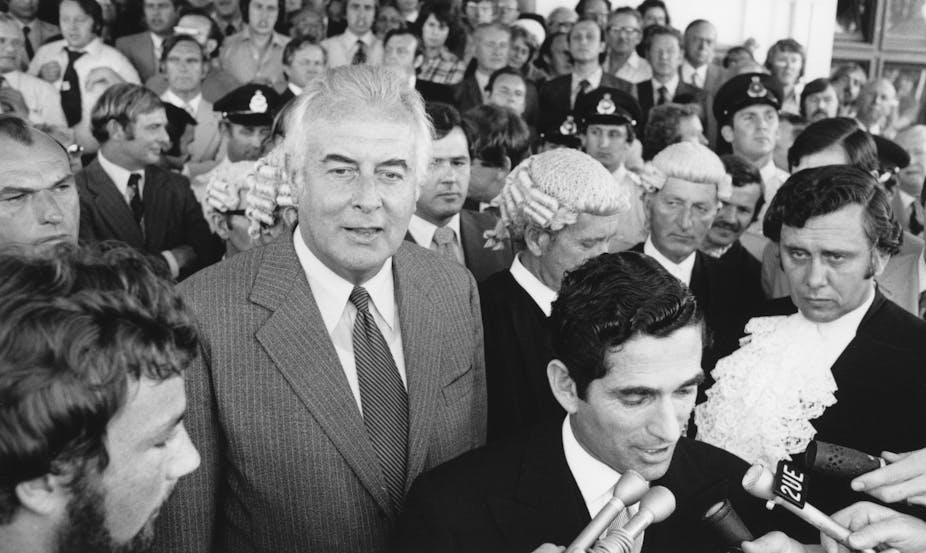Much hyperbole has been generated by the recent revelations concerning Sir Anthony Mason’s involvement in the 1975 dismissal, but for the most part it shows ignorance of the past.
Earlier this week, The Australian claimed it was “an unprecedented, extensive and unconventional relationship between a High Court judge and a Governor-General during a constitutional crisis.”
But not only was it not “unprecedented” or “unconventional” for a High Court judge to have advised a vice-regal representative on the extent of his or her powers back in 1975, it is actually quite hard to find an occasion when judges have not been involved in advising upon the exercise of reserve powers.
Nothing new
In 1975, the Governor-General of Australia, Sir John Kerr, dismissed Gough Whitlam as prime minister, after the opposition party, led then by Malcolm Fraser blocked supply through the senate.
A new book has revealed that Mason played a more significant role than previously known in advising the Governor-General on the scope of the reserve powers.
The very first victim of the exercise of these powers at the Commonwealth level was the first Labor prime minister, Chris Watson, whose four-month old government was terminated when the Governor-General Lord Northcote refused him an election. In exercising his reserve power to refuse Watson’s advice to dissolve the parliament and hold an election, Northcote relied upon advice about the extent of his powers from none other than the first Chief Justice of the High Court, Sir Samuel Griffith.
The Chief Justice also advised the Governor-General Lord Dudley on the refusal of a dissolution to the Fisher government in 1909 and most likely advised on the 1905 refusal of a dissolution to the Reid government, although there is not sufficient documentation to be sure in that case.
Chief Justice Griffith and Justice Barton, both drafters of the Constitution, freely advised the Governor-General Sir Ronald Munro Ferguson on many constitutional issues, including the extent of his discretion in relation to the grant of a double dissolution in 1914; how to deal with the resignation of Prime Minister Fisher in 1915; whether a referendum could be held over conscription; and how to deal with Prime Minister Hughes’ resignation after the second conscription referendum failed in 1917.
Greater stability
As the two-party system solidified and majority governments became the norm at the commonwealth level, there was no real call on the Governor-General to exercise reserve powers and therefore, no need for constitutional advice.
This did not mean that High Court justices were necessarily more circumspect about giving advice. Sir John Latham, for example, while Chief Justice of the High Court, apparently advised the prime minister on the drafting of a referendum to overturn the High Court’s judgment in the Communist Party case.
The next occasion for the exercise of reserve powers at the national level did not arise until the Prime Minister, Harold Holt, went missing in 1967. The Governor-General, having taken advice from the chief justice, Sir Garfield Barwick, exercised his reserve power to terminate Harold Holt’s commission as prime minister and appoint John McEwen until a new Liberal leader could be chosen.
Stately advice
In the meantime, at the state level, constitutional crises still abounded and advice was regularly given to governors by judges. In 1932, the NSW governor received advice from the NSW Chief Justice on dismissing the Lang Government, just as in 1927 his predecessor had received the Chief Justice’s advice on his reserve powers concerning the dissolution of Parliament and the “swamping” of the upper House.
In 1939, the next Chief Justice of the NSW Supreme Court advised the governor about a constitutional crisis involving the defeat of the government on a financial measure.
In Victoria, political instability and constitutional crises extended into the 1950s. In 1952, for example, the chief justice of the High Court, Sir Owen Dixon, along with the Chief Justice of the Victorian Supreme Court, advised the governor about a conflict very similar to 1975.
Labor, with the support of break-away Liberals, blocked supply in the upper House. The Governor refused the Country Party premier an election because supply would have run out during the election period. A new premier was commissioned, who managed to pass supply in the upper House but was then defeated in the lower House.
It was Sir Owen Dixon who advised the Governor to restore the former premier and grant him an election.
In 1955, Dixon again advised the Governor on how to deal with a government that was running out of supply but not prepared to recall Parliament and face a vote of no confidence.
Dixon also advised the Western Australian governor in 1956 and 1961 on other constitutional crises.
More context needed
These are only the cases that have come to light through research and the existence of relevant diaries and papers. No doubt they are the tip of the iceberg and that much more informal advice has been given to vice-regal officers from judges over the years.
Indeed, the Queen apparently receives informal advice from judges in the United Kingdom. She also obtains independent legal advice from her own solicitors and advice from academics. It is neither unprecedented, unusual, nor unconventional.
Looking at Sir Anthony Mason’s informal advice to Sir John Kerr through post-1975 eyes is unfair. In the context of the time, his actions were consistent with those of his predecessors or his colleagues.
Since 1975, there have been significant changes, with some of the actions of Governors-General becoming the subject of judicial review (although the reserve powers are still likely to be unreviewable) and with the High Court developing a much stricter separation of powers, prohibiting judges from taking on roles that involve advising the executive, even when they are acting in a non-judicial capacity.
While it would be unwise for a judge today to take on such a role, it is much harder to make that assessment in relation to actions taken in 1975.

